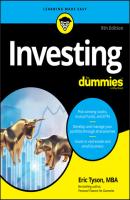Investing For Dummies. Eric Tyson
Чтение книги онлайн.

Читать онлайн книгу Investing For Dummies - Eric Tyson страница 12
Название: Investing For Dummies
Автор: Eric Tyson
Издательство: John Wiley & Sons Limited
Жанр: Личные финансы
isbn: 9781119716518
isbn:
And, of course, some people come into wealth through an inheritance. Even if your parents are among the rare wealthy ones and you expect them to pass on big bucks to you, you need to know how to invest that money intelligently.
Not everyone needs to make his money grow, of course. Suppose that you inherit a significant sum and/or maintain a restrained standard of living and work well into your old age simply because you enjoy doing so. In this situation, you may not need to take the risks involved with a potentially faster-growth investment. You may be more comfortable with safer investments, such as paying off your mortgage faster than necessary. Chapter 3 helps you think through such issues.
Entering the stock market
Stocks, which are shares of ownership in a company, are an example of an ownership investment. If you want to share in the growth and profits of companies like Skechers (footwear), you can! You simply buy shares of their stock through a brokerage firm. However, even if Skechers makes money in the future, you can’t guarantee that the value of its stock will increase.
Some companies today sell their stock directly to investors, allowing you to bypass brokers. You can also invest in stocks via a stock mutual fund (or an exchange-traded fund), where a fund manager decides which individual stocks to include in the fund. I discuss the various methods for buying stock in Chapter 6.
However, I don’t think you should expect that you can “beat the markets,” and you certainly are not likely to beat the best professional money managers at their own full-time game. This book shows you time-proven, non-gimmicky methods to make your money grow in the stock market as well as in other financial markets. I explain more about stocks and mutual funds in Part 2.
Owning real estate
People of varying economic means build wealth by investing in real estate. Owning and managing real estate is like running a small business. You need to satisfy customers (tenants), manage your costs, keep an eye on the competition, and so on. Some methods of real estate investing require more time than others, but many are proven ways to build wealth.
John, who works for a city government, and his wife, Linda, a computer analyst, have built several million dollars in investment real estate equity (the difference between the property’s market value and debts owed) over the decades. “Our parents owned rental property, and we could see what it could do for you by providing income and building wealth,” says John. Investing in real estate also appealed to John and Linda because they didn’t know anything about the stock market, so they wanted to stay away from it. The idea of leverage — making money with borrowed money — on real estate also appealed to them.
John and Linda bought their first property, a duplex, when their combined income was just $35,000 per year. Every time they moved to a new home, they kept the prior one and converted it to a rental. Now in their 50s, John and Linda own seven pieces of investment real estate and are multimillionaires. “It’s like a second retirement, having thousands in monthly income from the real estate,” says John.
John readily admits that rental real estate has its hassles. “We haven’t enjoyed getting some calls in the middle of the night, but now we have a property manager who can help with this when we’re not available. It’s also sometimes a pain finding new tenants,” he says.
Overall, John and Linda figure that they’ve been well rewarded for the time they spent and the money they invested. The income from John and Linda’s rental properties also allows them to live in a nicer home.
Running a small business
I know people who have hit investing home runs by owning or buying businesses. Unlike the part-time nature of investing in the stock market, most people work full time at running their businesses, increasing their chances of doing something big financially with them.
WHO WANTS TO INVEST LIKE A MILLIONAIRE?
Having a million dollars isn’t nearly as rare as it used to be. In fact, according to the Spectrem Group, a firm that conducts research on wealth, more than 11 million U.S. households now have at least $1 million in wealth (excluding the value of their primary home). More than 1.5 million households have $5 million or more in wealth.
Interestingly, households with wealth of at least $1 million rarely let financial advisors direct their investments. Only one of ten such households allows advisors to call the shots and make the moves, whereas 30 percent don’t use any advisors at all. The remaining 60 percent consult an advisor on an as-needed basis and then make their own moves.
As in past surveys, recent wealth surveys show that affluent investors achieved and built on their wealth with ownership investments, such as their own small businesses, real estate, and stocks.
For example, a decade ago, Calvin set out to develop a corporate publishing firm. Because he took the risk of starting his СКАЧАТЬ